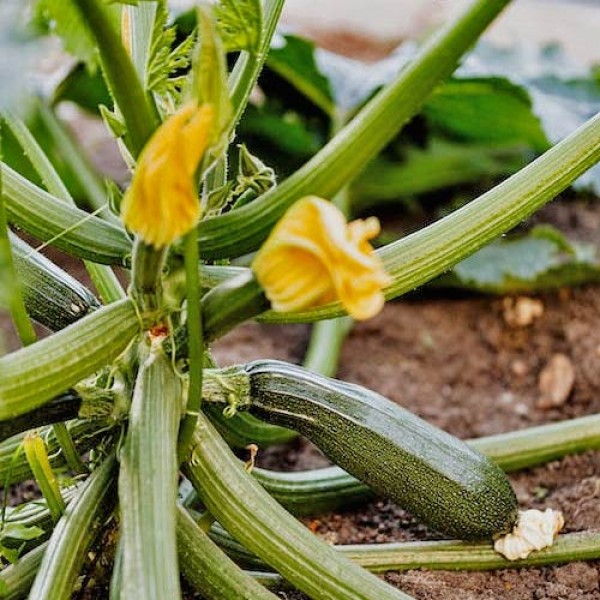
Growing Courgettes Yourself
Courgettes / Zucchini belong to the pumpkin family and originally come from Southern Europe. Translated, zucchini means "little pumpkin", which already indicates its relationship to the real pumpkin. But the vast majority of courgette varieties do not remain small. They grow quickly and extensively, and every garden owner needs to hurry to keep up with harvesting and utilising the courgettes. In France and Italy you will find the largest selection of varieties, and it is now impossible to imagine our home gardens without courgettes.
Location
The Courgette / Zucchini is an ideal plant for those who are just starting with gardening. If you provide the zucchini plant with a sunny spot, a rich harvest is practically guaranteed. The soil should be nutrient-rich for the zucchini plants. As the courgette evaporates a lot of water through its leaves, it needs plenty of water. The plant prefers a nutrient-rich, loose, and humus-rich soil. Avoid frost-sensitive locations, as the courgette is very heat-loving.
Sowing
Courgette is grown indoors from April to May. The germination period is only a few days. As the zucchini plant needs a lot of space (about 1-1.5 m² per plant, preferably more), you should not pre-cultivate too many young plants. Place 2-3 seeds together 2.5 cm deep into the soil. When the plants begin to grow, thin out the seedlings to the strongest plant. Otherwise, the plants will become too crowded, as they will not get enough light and air. You can transplant, give away, or dispose of the other two seedlings. The plants should not be planted outside until after the Ice Saints in mid-May, as they are very sensitive to frost. The courgette is relatively uncomplicated when it comes to neighbours. It gets along well with chard, peas, beans, corn and onions. However, tomatoes, potatoes, radishes and cucumbers should be avoided.
Care
The courgette plant needs a lot of nutrients and a lot of water. We recommend to work horn shavings or compost into the soil before planting outside. Keep the young plants weed-free. When the plant starts to flower and fruits form, regular abundant watering is very important, as a lack of water can lead to deformation of the fruits and a bitter taste. As courgettes are high nutrient-demanding pants, fertilisation is necessary at sowing, planting and during fruiting. A weekly application of nettle manure in the irrigation water has a strengthening effect on the leaves and ensures the supply of nutrients.
Harvesting
The courgette fruits are best harvested several times a week when they are not yet larger than 15 - 20 cm. The fruits can either be twisted off or cut off with a knife. Larger zucchinis are more durable, but they tend to become watery and lose flavor quickly. Not only the fruits of the courgettes can be eaten, but also the flowers. Harvesting the flowers can also help to limit the growth of the fruits. The decorative flowers can be fried, stuffed, or enjoyed in a delicious salad.
There are two types of flowers: male and female. While female flowers have short stems, male flowers have longer stems. They also differ in that female flowers have an ovary beneath the petals, which male flowers do not. When harvesting the flowers, it is important to avoid harvesting all of the male flowers, as they are important for pollination and thus for the formation of the courgettes. If the summer is cool and rainy, it is possible that more male flowers will grow.
Diseases and pests
Powdery mildew is more common in dry and hot areas. It often affects older or heavily shaded plants. Removing the affected leaves promptly can help, as can spraying with a baking soda-milk solution. Viral diseases such as cucumber mosaic virus, zucchini yellow mosaic virus, or watermelon mosaic virus are characterized by sharply defined, blister-like bulging leaf areas. Since mosaic viruses are typically transmitted by aphids, you can protect your plants from infestation by covering them with a fine-mesh vegetable net. Otherwise, courgettes are very vigorous and robust.
Storage
Courgettes can be stored in a cool and dark place for up to 12 days. However, you should not store them below 8 degrees Celsius, which is why the refrigerator is not an optimal storage location. You should also avoid storing zucchini near apples and tomatoes, as these emit ripening gases that cause the courgettes to ripen more quickly and thus spoil.
Manufacturer
Name: | Chili-Food-Wissen |
Address: |








